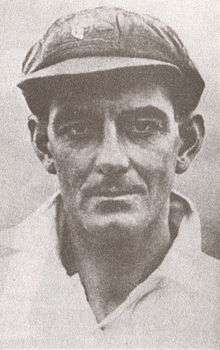Ted McDonald
 | ||||||||||||||||||||||||||||||||||||||||
| Personal information | ||||||||||||||||||||||||||||||||||||||||
|---|---|---|---|---|---|---|---|---|---|---|---|---|---|---|---|---|---|---|---|---|---|---|---|---|---|---|---|---|---|---|---|---|---|---|---|---|---|---|---|---|
| Full name | Edgar Arthur McDonald | |||||||||||||||||||||||||||||||||||||||
| Born |
6 January 1891 Launceston, Tasmania, Australia | |||||||||||||||||||||||||||||||||||||||
| Died |
22 July 1937 (aged 46) Blackrod, Lancashire, England | |||||||||||||||||||||||||||||||||||||||
| Batting style | Right-hand batsman | |||||||||||||||||||||||||||||||||||||||
| Bowling style | Right arm fast | |||||||||||||||||||||||||||||||||||||||
| Role | Bowler | |||||||||||||||||||||||||||||||||||||||
| International information | ||||||||||||||||||||||||||||||||||||||||
| National side | ||||||||||||||||||||||||||||||||||||||||
| Test debut (cap 114) | 14 January 1921 v England | |||||||||||||||||||||||||||||||||||||||
| Last Test | 29 November 1921 v South Africa | |||||||||||||||||||||||||||||||||||||||
| Domestic team information | ||||||||||||||||||||||||||||||||||||||||
| Years | Team | |||||||||||||||||||||||||||||||||||||||
| 1924–1931 | Lancashire | |||||||||||||||||||||||||||||||||||||||
| 1911/12–1921/22 | Victoria | |||||||||||||||||||||||||||||||||||||||
| 1909/10–1910/11 | Tasmania | |||||||||||||||||||||||||||||||||||||||
| Career statistics | ||||||||||||||||||||||||||||||||||||||||
| ||||||||||||||||||||||||||||||||||||||||
| Source: CricketArchive, 1 February 2009 | ||||||||||||||||||||||||||||||||||||||||
Edgar Arthur "Ted" McDonald (born 6 January 1891, at Launceston, Tasmania, died 22 July 1937, in a road accident at Blackrod, Lancashire) was a cricketer who played for Tasmania, Victoria, Lancashire and Australia, as well as being an Australian rules footballer who played with Launceston Football Club, Essendon Football Club, and Fitzroy Football Club.
A very fast bowler with the ability to cause problems even on docile pitches, Ted McDonald was the unexpected bowling sensation of the 1921 Australian tour to England. He and Jack Gregory caused something approaching panic among the England batsmen: John Evans' knees were allegedly knocking together when he went out to bat, and Andy Ducat was bowled when part of his bat, broken by McDonald's pace, hit the wicket. Where Gregory was able to swing the ball both ways, McDonald imparted vicious movement off the wicket. Like later fast bowling pairs, they were devastating in combination, taking 46 wickets in the series.
McDonald played a few matches for Victoria before the First World War, but came to prominence immediately after it with eight wickets in an innings in a state match. He was picked for three Test matches in the 1920–21 series against England, which Australia won 5–0, but had little success, his six wickets costing 65 runs each. In England the following summer, though, he was an instant success, taking eight wickets in the first Test at Trent Bridge and contributing significantly to the victories at Lord's and Headingley that won the series.
He was named as a Wisden Cricketer of the Year in 1922 for his exploits of the previous summer.
After the England tour, McDonald played in three Tests against South Africa in the 1921–22 series in South Africa. Those, however, were his last Tests – all of his Test cricket was contained within the calendar year of 1921 – as he then took up an engagement as a professional with the Lancashire League club Nelson.
By 1924, he had qualified to play for Lancashire, initially, because of his League commitments, in midweek games only. Again, he was a sensation. In his first full season, 1925, he took 205 wickets, and in the five seasons from 1926 to 1930, Lancashire won the County Championship four times, the most successful period in the county's history. In all, he took 1053 wickets for Lancashire. His value to the county was recognised in the award of a benefit in 1929, an unusually fast reward, for he had been playing county cricket for only five seasons.
McDonald's first-class career ended fairly suddenly. His form dipped in 1930, though he still took more than 100 wickets, but in 1931, he lost form almost entirely, taking just 26 wickets all season and being left out of the county team for half the matches. At the end of the season, he went back to the Lancashire League with Bacup.
He died, at the age of 46, when his car collided with another near Bolton, England, on the morning of 22 July 1937.
Australian rules football
He also played Australian rules football for Launceston,[1] and for Essendon Football Club (two matches in 1912) and Fitzroy Football Club (46 matches from 1913 to 1919).
See also
- List of Victoria first-class cricketers
- List of Tasmanian representative cricketers
- List of Australian rules football and cricket players
References
- ↑ "CITY v. LAUNCESTON.". Examiner (Launceston, Tas. : 1900–1954). Launceston, Tas.: National Library of Australia. 23 August 1909. p. 3 Edition: DAILY. Retrieved 13 August 2011.
- Maplestone, M., Flying Higher: History of the Essendon Football Club 1872–1996, Essendon Football Club, (Melbourne), 1996. ISBN 0-9591740-2-8
- Peter Pierce, "McDonald, Edgar Arthur (Ted) (1891–1937)", pp.pp 249–250 in Australian Dictionary of Biography, Vol.10, Melbourne University Press, (Melbourne), 1986.
External links
- Ted McDonald's statistics from AFL Tables
- Cricinfo Player Profile: Ted McDonald
- Peter Pierce, "McDonald, Edgar Arthur (Ted) (1891–1937)", Australian Dictionary of Biography, Online Edition
- Brydon Coverdale, "Australia's Winter Allrounders: XI Test Cricketers who played Australian Rules football at the highest level", Cricinfo, 28 May 2007
- Tasmanian Sporting Hall of Fame Member's Biography: Edgar Arthur ('Ted') McDonald, Cricket
| Sporting positions | ||
|---|---|---|
| Preceded by George Geary |
Nelson Cricket Club Professional 1922–1924 |
Succeeded by Jimmy Blanckenberg |